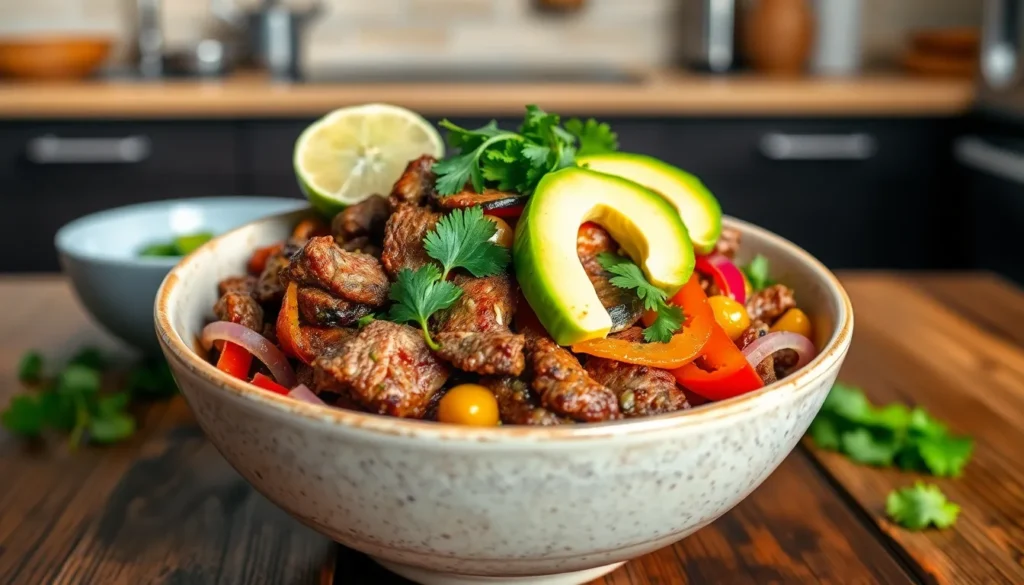We’re bringing all the sizzling flavors of your favorite tex-mex restaurant straight to your kitchen with this incredible beef fajita bowl recipe. There’s something magical about tender strips of seasoned beef paired with colorful bell peppers and onions that transforms an ordinary weeknight dinner into a fiesta of flavors.
What makes this dish absolutely irresistible is how it captures that authentic fajita experience in a convenient bowl format. We’ve packed all the traditional elements – perfectly seasoned beef, caramelized vegetables, and fresh toppings – into one satisfying meal that’s easier to eat and customize than traditional fajitas.
The best part? This recipe delivers restaurant-quality results in just 30 minutes using simple ingredients you likely already have in your pantry. Whether you’re meal prepping for the week or feeding a hungry family tonight, these beef fajita bowls will become your new go-to dinner solution that everyone will be asking for again and again.
Ingredients
We’ll break down our beef fajita bowl ingredients into four simple categories to keep everything organized. Each component brings its own flavor profile that creates the perfect harmony in every bite.
For the Beef
- 1 lb flank steak or skirt steak, sliced against the grain into thin strips
- 2 tablespoons olive oil
- 1 tablespoon chili powder
- 1 teaspoon ground cumin
- 1 teaspoon smoked paprika
- 1 teaspoon garlic powder
- 1 teaspoon onion powder
- 1/2 teaspoon oregano
- 1/2 teaspoon salt
- 1/4 teaspoon black pepper
- 2 tablespoons lime juice
For the Vegetables
- 2 medium bell peppers (red and yellow), sliced into strips
- 1 large yellow onion, sliced into half moons
- 2 tablespoons olive oil
- 1/2 teaspoon salt
- 1/4 teaspoon black pepper
- 1 tablespoon lime juice
For the Rice
- 1 cup long grain white rice
- 1 3/4 cups chicken broth
- 1 tablespoon butter
- 1/2 teaspoon salt
- 1/4 cup fresh cilantro, chopped
- 2 tablespoons lime juice
For the Toppings
- 1 cup shredded Mexican cheese blend
- 1/2 cup sour cream
- 1 large avocado, diced
- 1/4 cup fresh cilantro, chopped
- 2 limes, cut into wedges
- 1/4 cup pickled jalapeños
- 1 cup cherry tomatoes, halved
Equipment Needed
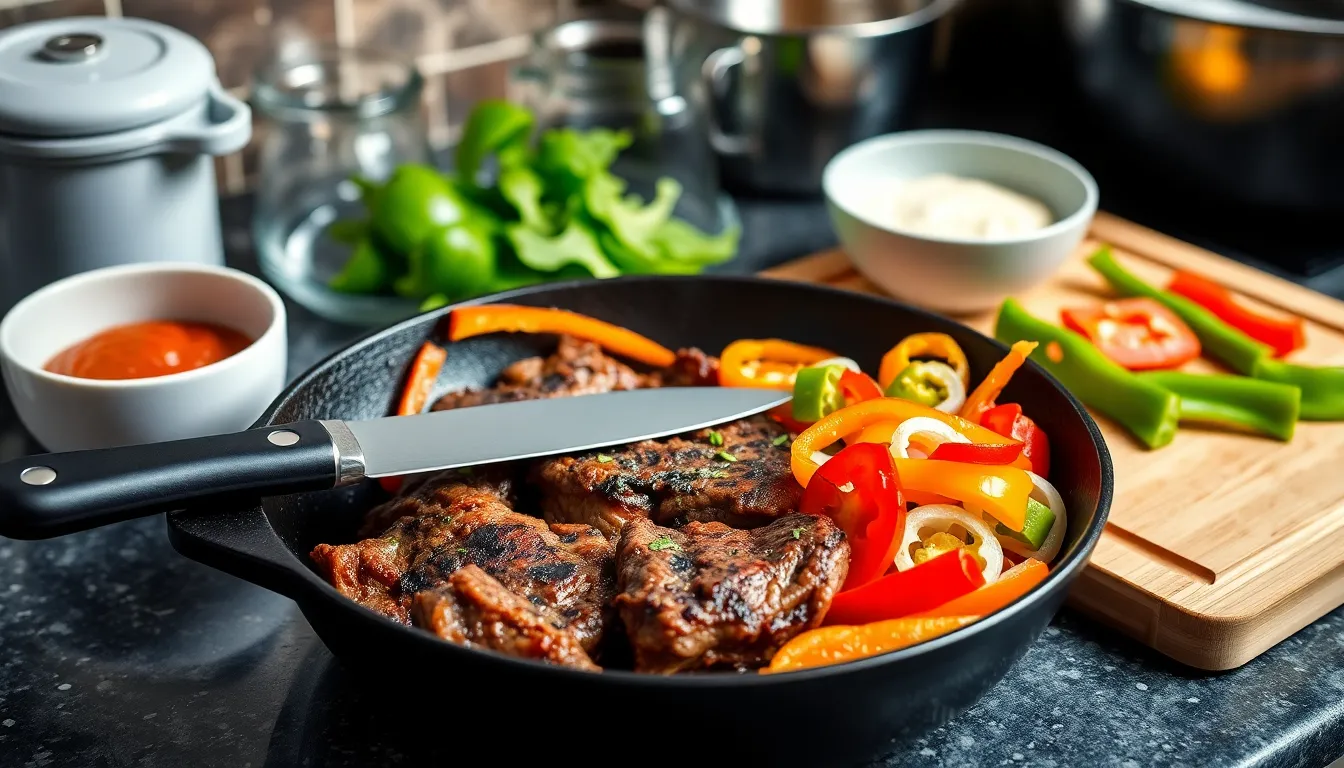
Creating the perfect beef fajita bowl requires basic kitchen equipment that most home cooks already have on hand. We recommend gathering these essential tools before starting your cooking process to ensure smooth preparation and assembly.
Essential Cooking Equipment
Skillet or Frying Pan serves as our primary cooking vessel for both the seasoned beef and sautéed vegetables. A cast iron or stainless steel pan works best for achieving the perfect sear on your steak while developing those coveted caramelized edges on peppers and onions.
Sharp Knife becomes crucial for slicing the marinated steak against the grain and cutting bell peppers and onions into uniform strips. We suggest using a chef’s knife or carving knife for clean, precise cuts that enhance both presentation and texture.
Cutting Board provides our safe workspace for all ingredient preparation. Choose a large board that accommodates both meat and vegetable prep, or use separate boards if you prefer to keep proteins and produce separated.
Preparation Tools
Mixing Bowl or Resealable Bag holds our steak marinade and allows the flavors to penetrate the meat effectively. A gallon-sized zip-top bag works particularly well for marinating as it ensures even coating and takes up minimal refrigerator space.
Measuring Spoons and Cups ensure accurate seasoning and marinade proportions for consistent flavor in every batch. Precise measurements make the difference between good fajita bowls and exceptional ones.
Spoon or Spatula helps us stir vegetables while cooking and assists with serving the finished components into bowls. A wooden spoon or silicone spatula works best to avoid scratching your cookware.
Serving Equipment
Serving Bowls complete our setup for assembling individual fajita bowls. Choose bowls large enough to accommodate rice, protein, vegetables, and generous toppings without overcrowding.
Optional Equipment
Instant Pot or Slow Cooker offers convenient alternatives for busy home cooks who prefer hands-off cooking methods. These appliances work particularly well for meal prep versions of beef fajita bowls.
| Equipment Type | Essential Items | Optional Items |
|---|---|---|
| Cooking | Skillet, Knife, Cutting Board | Instant Pot, Slow Cooker |
| Preparation | Mixing Bowl, Measuring Tools, Spatula | – |
| Serving | Large Bowls | – |
This straightforward equipment list ensures you have everything needed to create restaurant-quality beef fajita bowls in your own kitchen. Most items are standard kitchen staples, making this recipe accessible for cooks at any experience level.
Prep Work
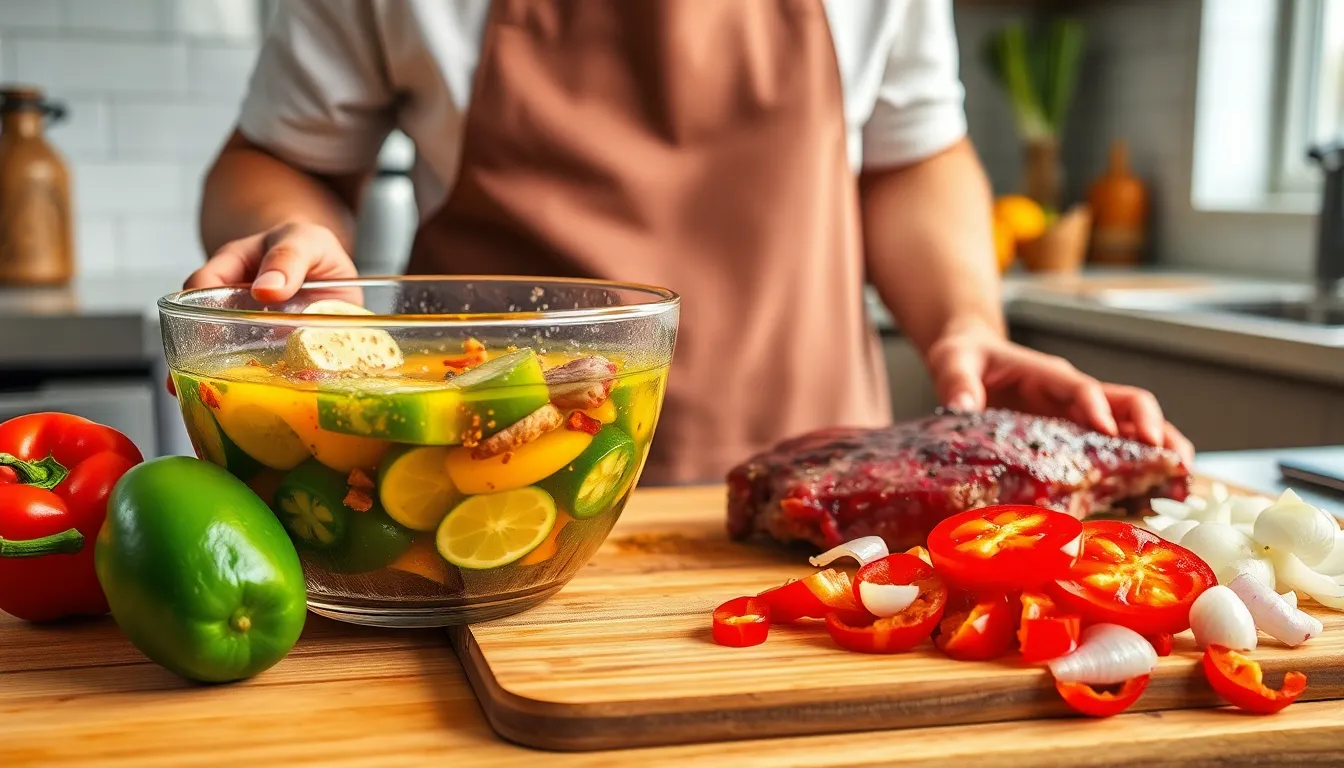
Proper preparation sets the foundation for creating restaurant-quality beef fajita bowls. We’ll break down the essential prep steps to ensure our ingredients are perfectly seasoned and ready for cooking.
Marinating the Beef
We start by creating a flavorful marinade that transforms ordinary steak into tender, zesty perfection. In a mixing bowl, we whisk together olive oil, lime juice, minced garlic, chopped cilantro, cumin, smoked paprika, chili powder, salt, and pepper. The combination of citrus acid and aromatic spices works to break down the meat fibers while infusing deep flavor.
Place our flank steak or skirt steak in the marinade, ensuring every surface gets well coated. We prefer using a reusable bag or shallow bowl for this step. The steak needs to refrigerate for a minimum of 2 hours, though overnight marination delivers the most intense flavor development. Before cooking, we remove excess marinade and season the steak with an additional pinch of salt for optimal taste.
Preparing the Vegetables
Fresh bell peppers and onions form the colorful vegetable base of our fajita bowls. We slice the bell peppers and onions into uniform strips to ensure even cooking. This consistent sizing helps achieve that perfect balance of tender texture with slight char marks.
We heat a tablespoon of avocado oil or olive oil in our skillet over medium-high heat until it shimmers. The vegetables go into the hot pan with a pinch of salt, where we sauté them for 4 to 5 minutes. Our goal is vegetables that remain slightly charred yet tender, creating that authentic fajita flavor and texture.
Cooking the Rice
The rice component provides a satisfying base that absorbs all the delicious flavors in our bowl. For traditional rice, we cook parboiled rice using low sodium chicken broth instead of water, adding minced garlic and butter for enhanced flavor depth.
Cilantro lime rice offers a zesty alternative that we create by cooking rice normally, then mixing in fresh lime juice and chopped cilantro after cooking. Those seeking a low-carb option can sauté frozen cauliflower rice in a skillet with oil and salt until tender, finishing with a squeeze of lime juice for brightness and flavor balance.
Instructions
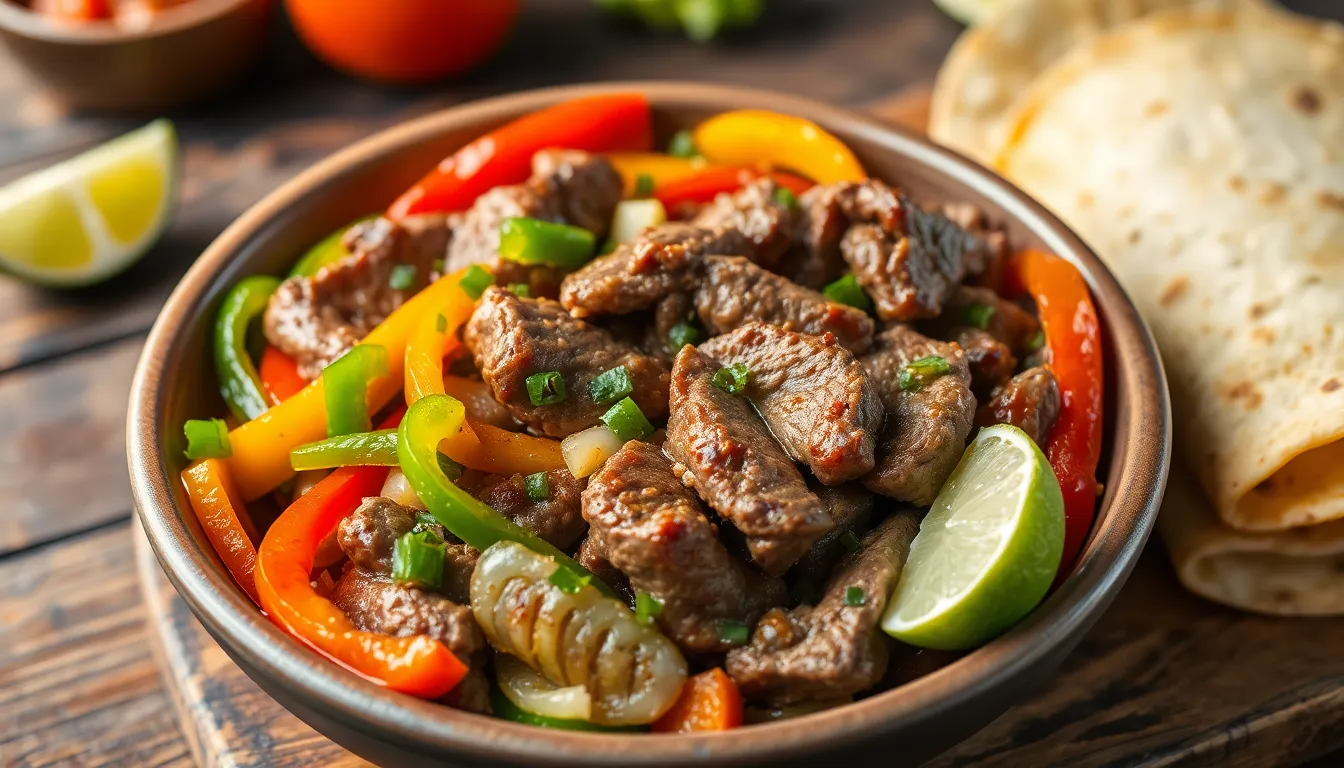
We’ll walk through each cooking step to create the perfect beef fajita bowl with restaurant-quality results. These simple techniques ensure tender meat and perfectly caramelized vegetables.
Cook the Beef
We start by removing our marinated steak from the refrigerator and letting it come to room temperature for about 15 minutes. Heat a large skillet over high heat and add 1 tablespoon of avocado oil. Once the oil shimmers, carefully place the steak in the pan and cook for 4 minutes without moving it to develop a beautiful sear.
Flip the steak and cook for another 3-4 minutes for medium-rare doneness. We remove the steak to a cutting board and tent it with foil to rest for 5 minutes. This resting period allows the juices to redistribute throughout the meat.
After resting, we slice the steak thinly against the grain using a sharp knife. Cutting against the grain breaks down the muscle fibers and ensures each bite is tender. We drizzle any accumulated juices over the sliced beef to maximize flavor.
Sauté the Vegetables
Using the same skillet with the flavorful beef drippings, we add 1 tablespoon of oil over medium-high heat. We add the sliced bell peppers and onions to the hot pan and season with the remaining fajita seasoning blend.
We cook the vegetables for 5-7 minutes, stirring occasionally to ensure even cooking. The peppers and onions should develop slight char marks while maintaining a tender-crisp texture. We add 2 teaspoons of soy sauce and a squeeze of fresh lime juice during the last minute of cooking.
The vegetables are ready when they’re slightly caramelized and have softened but still retain some bite. We taste and adjust seasoning with additional salt or lime juice as needed.
Warm the Tortillas (Optional)
We heat a dry skillet or griddle over medium heat for warming tortillas. Place each tortilla in the hot pan for 30 seconds, then flip and warm for another 20-30 seconds until pliable and lightly spotted.
Alternatively, we can wrap the tortillas in damp paper towels and microwave them for 30-45 seconds. For serving a crowd, we wrap the tortillas in foil and warm them in a 350°F oven for 10 minutes.
We keep the warmed tortillas covered with a clean kitchen towel to maintain their heat and flexibility until serving time.
Assembly Instructions
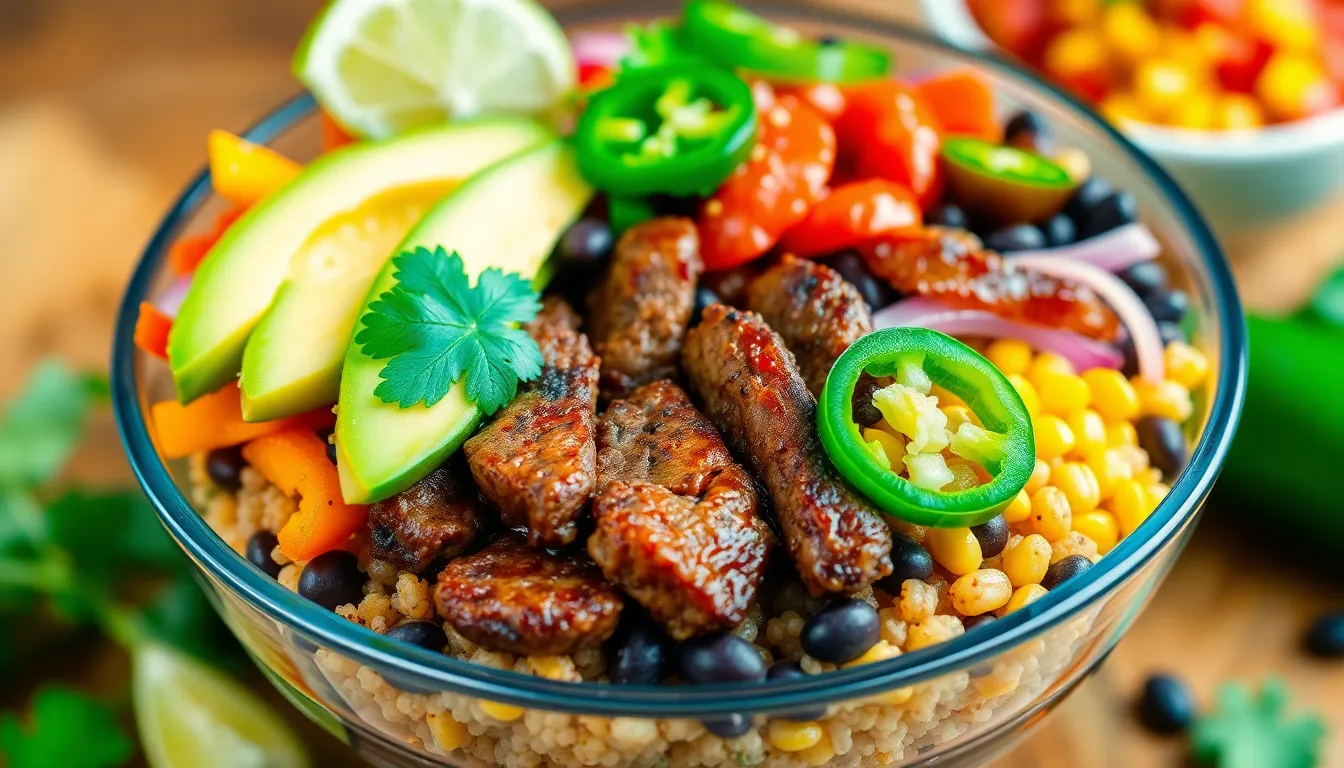
Creating the perfect beef fajita bowl is all about strategic layering and thoughtful placement of ingredients. We build each component to maximize flavor and visual appeal while ensuring every bite delivers the ideal combination of textures.
Layer the Bowl
We start with our cooked quinoa or rice as the foundation, creating a generous base that covers the bottom of each serving bowl. This grain base provides the perfect canvas for absorbing all the delicious flavors from the beef and vegetables above.
Next, we arrange the sliced steak evenly across the grain base, ensuring each portion gets an equal amount of protein. The beef should still be warm from resting, allowing its juices to mingle with the rice or quinoa below.
We then add our sautéed bell peppers and onions directly on top of the steak, distributing them evenly around the bowl. The vegetables’ slight char and tender texture create a beautiful contrast against the grain base while maintaining their vibrant colors.
Add the Toppings
We begin the topping process by adding sliced avocado in a fan pattern along one side of the bowl. The creamy texture provides a cooling element that balances the spiced beef perfectly.
Fresh cilantro gets sprinkled generously over the entire bowl, adding a bright pop of color and herbaceous flavor. We follow this with a dollop of salsa placed strategically on one side for easy access.
Black beans and corn kernels can be scattered around the bowl’s perimeter, creating colorful pockets of additional protein and sweetness. These ingredients add both nutritional value and textural variety to each forkful.
Finally, we finish with jalapeño slices for heat lovers and a generous squeeze of fresh lime juice over the entire bowl. A drizzle of Botana sauce adds an extra layer of flavor for those seeking additional zest and complexity.
Make-Ahead Tips
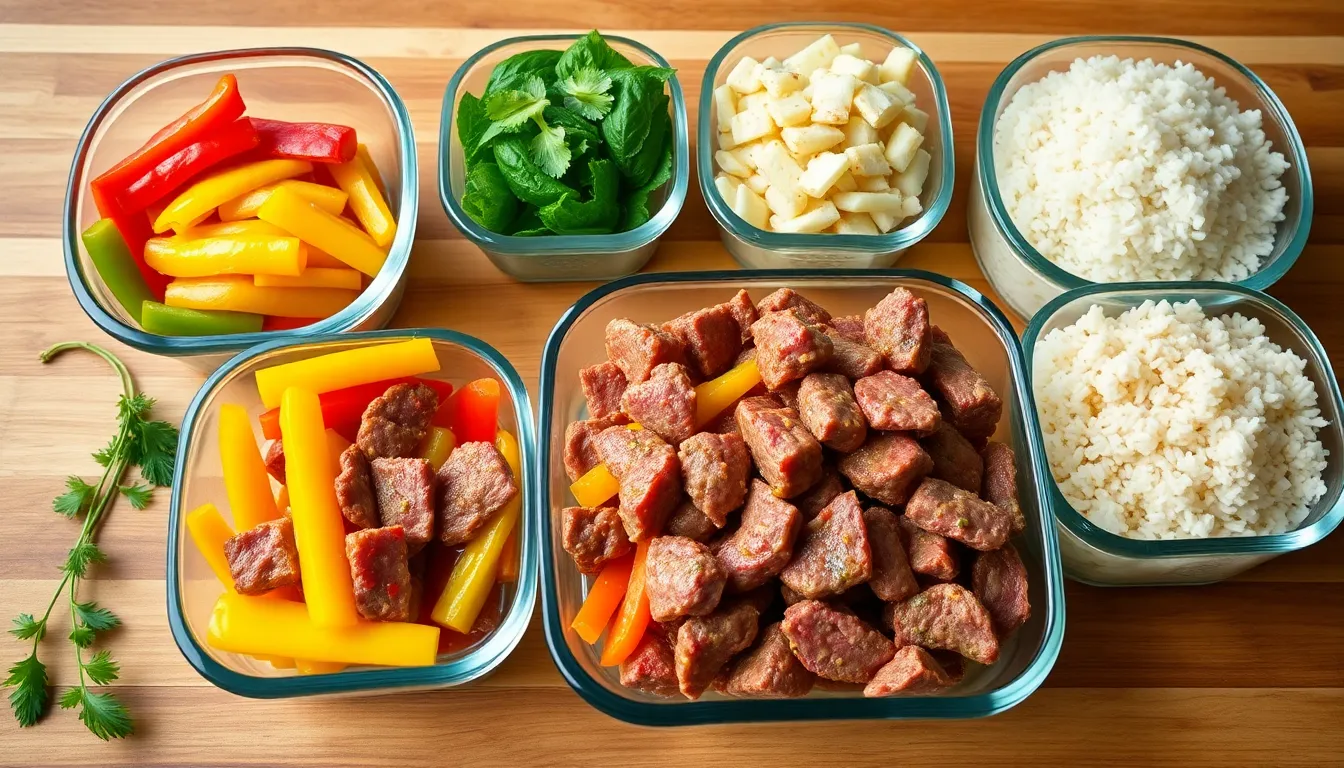
Preparing our beef fajita bowls ahead of time transforms this delicious meal into a convenient weeknight solution. We can streamline the entire cooking process by implementing strategic prep work that saves both time and effort during busy weekdays.
Marinating the Beef
Our first make-ahead strategy involves marinating the steak strips overnight to enhance their flavor profile. We recommend cutting the flank or strip steak into strips and placing them in our spice mixture the evening before cooking. This extended marination period allows the chili powder, cumin, garlic powder, and other seasonings to penetrate the meat fibers completely. The overnight process creates more tender and flavorful beef that requires less cooking time when we’re ready to prepare our bowls.
Vegetable Preparation
We can slice our bell peppers and onions ahead of time for quicker preparation on cooking day. Store the sliced vegetables in airtight containers in the refrigerator where they’ll remain fresh and ready to use. This simple step eliminates the chopping time when we’re ready to cook and ensures uniform pieces that cook evenly in our skillet.
Rice Components
Our rice base benefits significantly from advance preparation since we can cook white, brown, or cauliflower rice up to one day before serving. Store the cooked rice in the refrigerator in covered containers to maintain freshness and prevent moisture loss. This approach allows us to focus on the beef and vegetables during final preparation while ensuring our base remains perfectly textured.
Complete Meal Prep Assembly
We can prepare the entire fajita mixture and rice in meal prep containers for ultimate convenience. The assembled bowls refrigerate safely for up to 4 days or freeze for longer storage periods. This method works particularly well for weekly meal planning since we can portion individual servings that grab easily from the refrigerator.
Reheating Instructions
| Storage Method | Reheating Time | Temperature |
|---|---|---|
| Refrigerated | 2.5 minutes | Microwave |
| Frozen | 3.5 minutes | Microwave |
When reheating our prepared bowls, we microwave refrigerated portions for approximately 2.5 minutes and frozen portions for about 3.5 minutes. These timing guidelines ensure our beef remains tender while our vegetables retain their ideal texture without becoming overcooked.
Freezer-Friendly Options
We can marinate and freeze the seasoned meat ahead of time for extended storage. This technique allows us to prepare larger batches when steak goes on sale, then cook individual portions when needed. The frozen marinated beef thaws quickly and cooks directly from the freezer when time constraints demand immediate meal preparation.
Storage Instructions
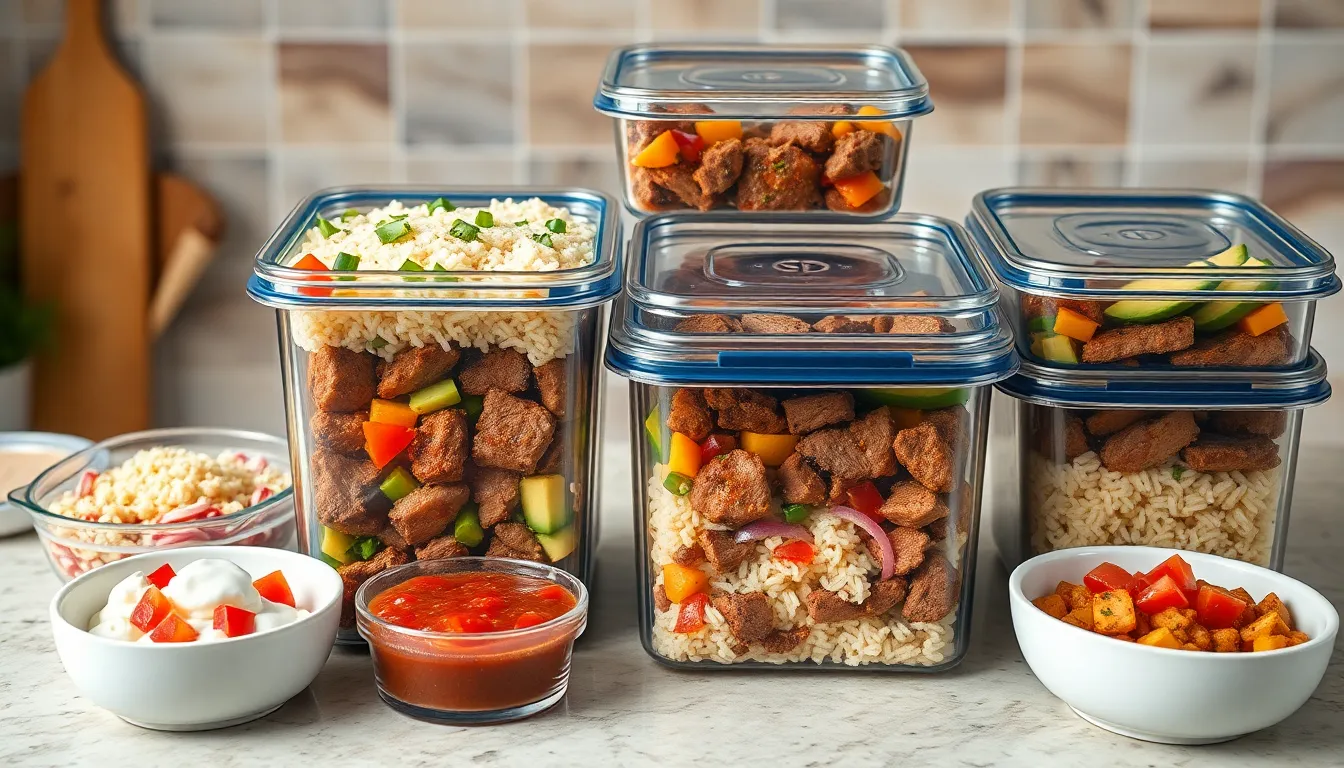
Proper storage techniques help maintain the fresh flavors and quality of your beef fajita bowls for several days after preparation.
Refrigerator Storage
We recommend storing assembled bowls or individual components in airtight containers for optimal freshness. The cooked rice, seasoned steak, and sautéed vegetables can be stored together in the same container, but fresh toppings like avocado, salsa, and sour cream should remain separate until serving time.
Our beef fajita bowls stay fresh in the refrigerator for 3 to 4 days when properly stored. Ground beef variations of this recipe follow the same storage timeline, though we suggest keeping the components separate for easier reheating.
Temperature control plays a crucial role in food safety, so ensure your refrigerator maintains a consistent temperature below 40°F. Label your containers with the preparation date to track freshness accurately.
Freezer Storage
Freezing works best for seasoned ground beef components, which maintain their quality for up to 3 months in the freezer. Cooked bell peppers and onions also freeze well, though they may soften slightly during the thawing and reheating process.
We generally advise against freezing complete steak fajita bowls, as the texture and flavor of the beef can degrade significantly. Rice components freeze adequately but may require additional moisture when reheated.
Use freezer-safe containers or heavy-duty freezer bags to prevent freezer burn and maintain optimal flavor. Remove as much air as possible before sealing to preserve quality.
Reheating Methods
Microwave reheating offers the most convenient option for busy schedules. Heat your fajita bowl for 2 to 3 minutes, adding a splash of water or broth to rice and vegetables if they appear dry during the process.
Stovetop reheating provides better texture control, particularly for steak and vegetables. Heat components separately in a skillet over medium heat, stirring occasionally until warmed through.
Always reheat your beef fajita bowls without fresh toppings like avocado, cilantro, or salsa. Add these fresh ingredients after reheating to maintain their vibrant flavors and appealing textures.
| Storage Method | Duration | Best For |
|---|---|---|
| Refrigerator | 3-4 days | Complete bowls and components |
| Freezer | 3 months | Ground beef and cooked vegetables |
| Room Temperature | 2 hours maximum | Immediate consumption only |
Serving Suggestions
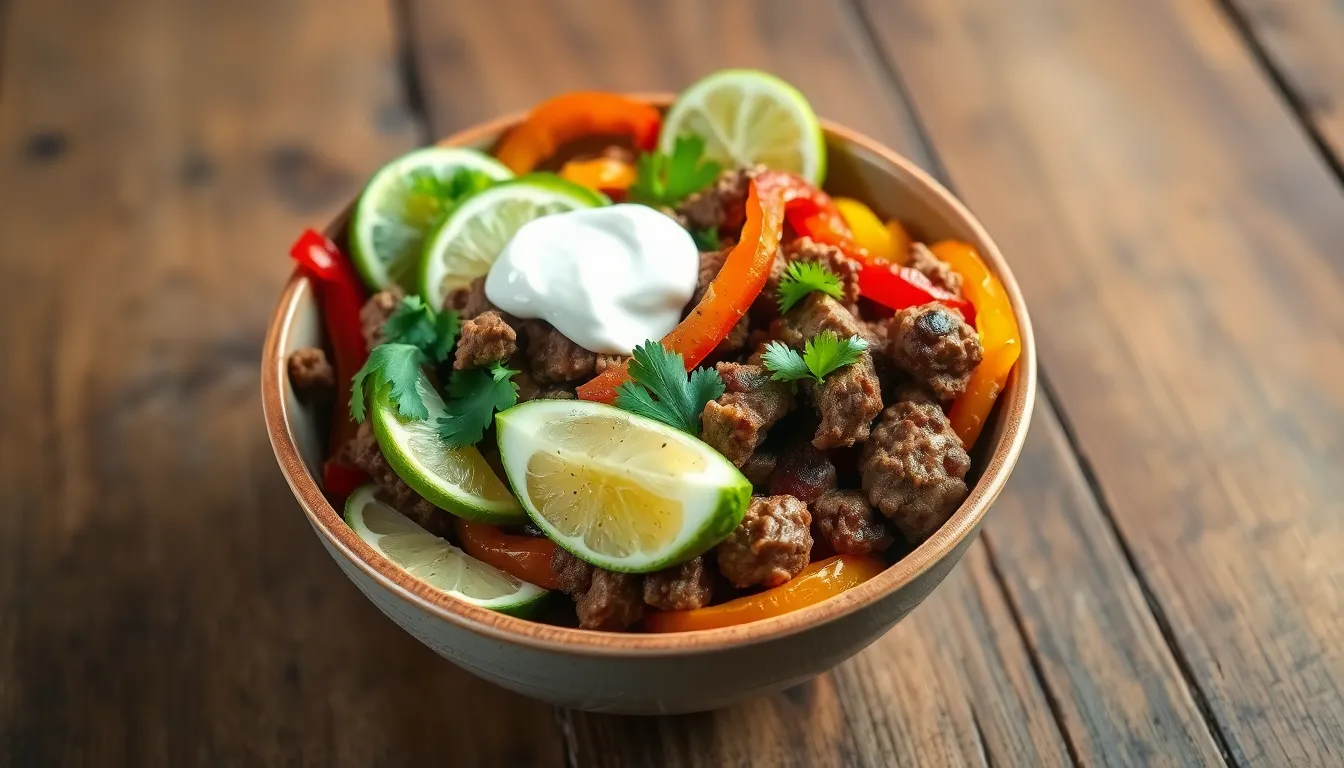
We recommend serving our beef fajita bowls with freshly squeezed lime wedges on the side for that extra burst of tanginess that elevates every bite. The bright acidity cuts through the rich flavors and awakens your taste buds.
A generous dollop of sour cream or creamy jalapeño sauce helps balance the spices while adding luxurious richness to each forkful. We find this cooling element essential for taming any heat from the seasoned beef and peppers.
Fresh avocado slices or a scoop of homemade guacamole complement the robust flavors beautifully while contributing welcomed creaminess to the bowl. These healthy fats also help your body absorb the fat-soluble vitamins from the colorful vegetables.
Sprinkle fresh cilantro generously over the top to enhance the aromatic profile and add a pop of vibrant green color. This herb brightens the entire dish and provides that authentic Mexican restaurant experience we all crave.
Consider adding a side of chunky salsa or fresh pico de gallo to provide brightness and acidity that makes each bite more exciting. The tomatoes and onions in these accompaniments echo the vegetable flavors already present in the bowl.
Chili roasted corn kernels or simple canned corn add natural sweetness and satisfying texture that contrasts beautifully with the tender beef. We love how the corn kernels burst with flavor and provide delightful pops of color throughout the bowl.
For a complete meal experience pair your beef fajita bowl with a crisp green salad dressed in lime vinaigrette or serve alongside warm tortilla chips for extra crunch. These additions transform our already satisfying bowl into a feast that feeds both body and soul.
Recipe Variations
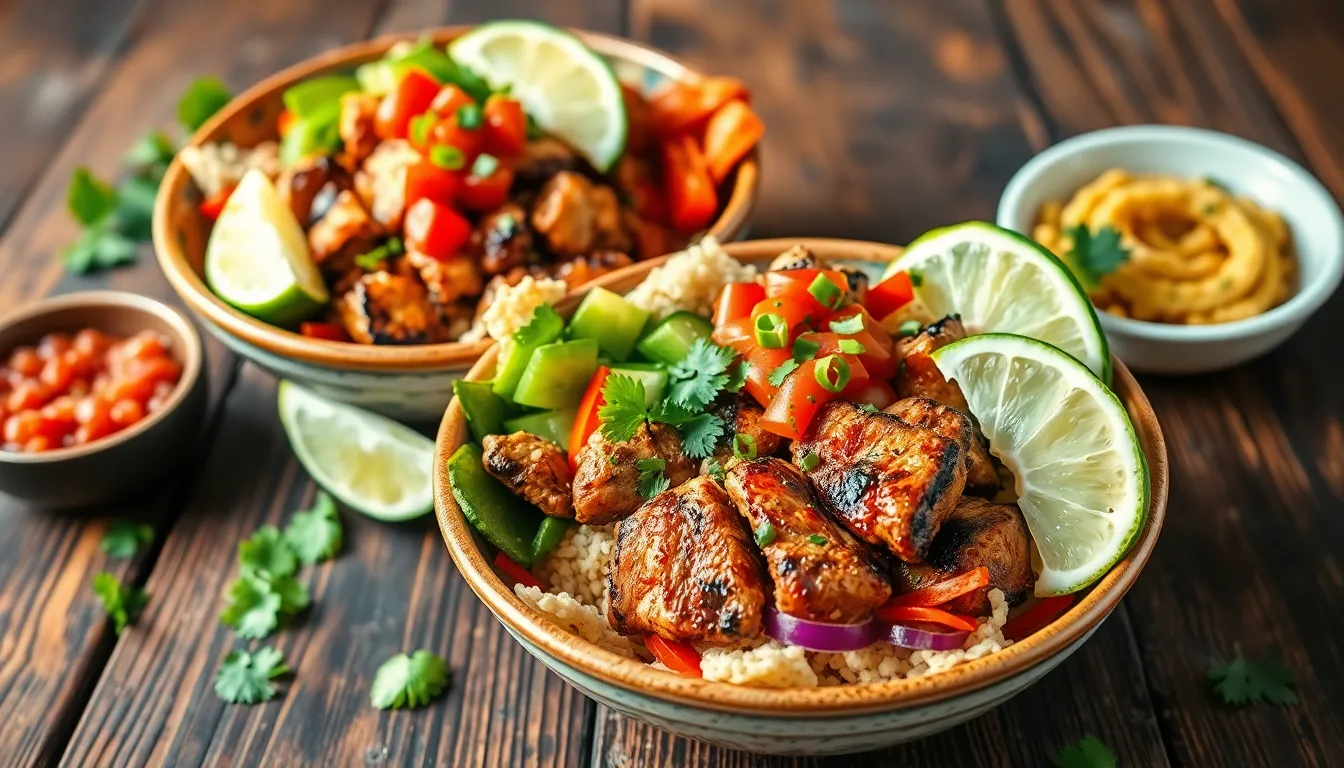
We love how versatile this beef fajita bowl recipe becomes when you swap out the protein or go completely plant-based. These variations maintain the same bold fajita flavors while accommodating different dietary preferences and protein choices.
Chicken Fajita Bowl
We recommend using boneless chicken breast or thighs for this leaner protein alternative. Season the chicken with the same fajita spice blend we use for beef: chili powder, garlic powder, smoked paprika, cumin, oregano, salt, and pepper. Marinate the chicken pieces for at least 30 minutes in olive oil, lime juice, and spices before cooking.
Grill or sauté the seasoned chicken in a hot skillet for 6-8 minutes per side until it reaches an internal temperature of 165°F. Let the chicken rest for 5 minutes before slicing it into strips. We sauté the bell peppers and onions using the same technique as the beef version, creating that signature charred flavor.
Assemble your chicken fajita bowl over cilantro lime rice or cauliflower rice for keto dieters. Top with fresh avocado, salsa, shredded cheese, and a squeeze of lime for a complete meal that delivers all the classic fajita taste with a lighter protein option.
Vegetarian Fajita Bowl
We transform this recipe into a satisfying plant-based meal by replacing meat with hearty vegetables or plant proteins. Portobello mushrooms work exceptionally well when sliced thick and seasoned with our fajita spice blend. Sauté them until they develop a rich, meaty texture and golden-brown edges.
Alternative protein options include seasoned tofu, tempeh, or black beans for added substance. We season these proteins with the same spice mixture and cook them until heated through and slightly crispy. The key lies in building layers of flavor through proper seasoning and cooking techniques.
Serve your vegetarian fajita bowl over quinoa or brown rice for added protein and fiber. We load these bowls with extra toppings like guacamole, pico de gallo, roasted corn, and pickled jalapeños to create a vibrant, satisfying meal that never leaves you missing the meat.
Conclusion
This beef fajita bowl recipe transforms weeknight dinners into something special. We’ve shown you how to create restaurant-quality flavors at home using simple ingredients and straightforward techniques.
The beauty of this dish lies in its flexibility – you can prep ahead for busy weeks or customize it to suit different dietary needs. Whether you’re feeding a family or meal prepping for yourself the combination of tender seasoned beef colorful vegetables and fresh toppings delivers satisfaction every time.
We’re confident this recipe will become a staple in your kitchen rotation. The bold flavors vibrant colors and easy assembly make it perfect for any occasion. Give it a try tonight and taste the difference homemade makes!
Frequently Asked Questions
How long does it take to make beef fajita bowls?
You can prepare restaurant-quality beef fajita bowls in just 30 minutes using simple pantry ingredients. However, for best results, marinate the beef for at least 2 hours beforehand, with overnight marinating being ideal for enhanced flavor and tenderness.
What cut of beef works best for fajita bowls?
Flank steak or skirt steak are the ideal cuts for beef fajita bowls. These cuts become tender and flavorful when marinated properly and sliced against the grain. They also cook quickly in a hot skillet for that perfect seared exterior.
Can I make beef fajita bowls ahead of time?
Yes, beef fajita bowls are excellent for meal prep. You can marinate the beef overnight, slice vegetables in advance, and cook rice a day prior. Assembled bowls can be stored in the refrigerator for up to 4 days or individual components can be frozen for longer storage.
What equipment do I need to make beef fajita bowls?
You’ll need basic kitchen equipment that most home cooks already have: a skillet or frying pan, sharp knife, cutting board, mixing bowl for marinating, measuring spoons, and serving bowls. Optional equipment includes an Instant Pot or slow cooker for hands-off cooking methods.
How should I store leftover beef fajita bowls?
Store assembled bowls or individual components in airtight containers in the refrigerator for 3-4 days. Keep fresh toppings separate until serving. Seasoned ground beef components can be frozen for up to 3 months, but complete steak fajita bowls aren’t recommended for freezing due to texture issues.
What are good substitutes for beef in fajita bowls?
For chicken fajita bowls, use boneless chicken breast or thighs seasoned and cooked similarly to beef. Vegetarian options include Portobello mushrooms, tofu, or black beans. These alternatives maintain the bold fajita flavors while accommodating different dietary preferences and protein choices.
What toppings work best for beef fajita bowls?
Popular toppings include shredded cheese, sour cream, sliced avocado, fresh cilantro, salsa, black beans, corn, pickled jalapeños, and lime wedges. Layer these strategically over your rice base, beef, and sautéed vegetables for optimal flavor and visual appeal.
How do I reheat beef fajita bowls properly?
Reheat beef fajita bowls in the microwave or on the stovetop, keeping fresh toppings separate until serving. For microwave reheating, cover and heat in 30-second intervals. For stovetop, warm components separately in a skillet over medium heat to maintain proper textures.

